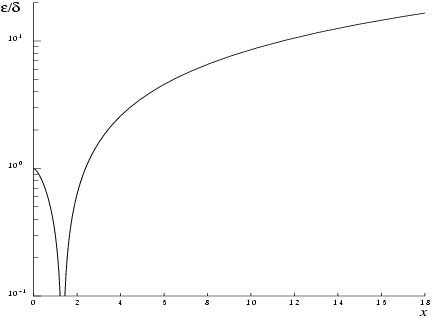PDF version (NAG web site
, 64-bit version, 64-bit version)
NAG Toolbox: nag_specfun_bessel_k1_real_vector (s18ar)
Purpose
nag_specfun_bessel_k1_real_vector (s18ar) returns an array of values of the modified Bessel function .
Syntax
Description
nag_specfun_bessel_k1_real_vector (s18ar) evaluates an approximation to the modified Bessel function of the second kind for an array of arguments , for .
Note: is undefined for and the function will fail for such arguments.
The function is based on five Chebyshev expansions:
For
,
For
,
For
,
For
,
For
near zero,
. This approximation is used when
is sufficiently small for the result to be correct to
machine precision. For very small
it is impossible to calculate
without overflow and the function must fail.
For large , where there is a danger of underflow due to the smallness of , the result is set exactly to zero.
References
Abramowitz M and Stegun I A (1972) Handbook of Mathematical Functions (3rd Edition) Dover Publications
Parameters
Compulsory Input Parameters
- 1:
– double array
-
The argument of the function, for .
Constraint:
, for .
Optional Input Parameters
- 1:
– int64int32nag_int scalar
-
Default:
the dimension of the array
x.
, the number of points.
Constraint:
.
Output Parameters
- 1:
– double array
-
, the function values.
- 2:
– int64int32nag_int array
-
contains the error code for
, for
.
- No error.
- , is undefined. contains .
- is too small, there is a danger of overflow. contains zero. The threshold value is the same as for in nag_specfun_bessel_k1_real (s18ad), as defined in the Users' Note for your implementation.
- 3:
– int64int32nag_int scalar
unless the function detects an error (see
Error Indicators and Warnings).
Error Indicators and Warnings
Errors or warnings detected by the function:
Cases prefixed with W are classified as warnings and
do not generate an error of type NAG:error_n. See nag_issue_warnings.
- W
-
On entry, at least one value of
x was invalid.
Check
ivalid for more information.
-
-
Constraint: .
-
An unexpected error has been triggered by this routine. Please
contact
NAG.
-
Your licence key may have expired or may not have been installed correctly.
-
Dynamic memory allocation failed.
Accuracy
Let and be the relative errors in the argument and result respectively.
If
is somewhat larger than the
machine precision (i.e., if
is due to data errors etc.), then
and
are approximately related by:
Figure 1 shows the behaviour of the error amplification factor
However if
is of the same order as the
machine precision, then rounding errors could make
slightly larger than the above relation predicts.
For small , and there is no amplification of errors.
For large , and we have strong amplification of the relative error. Eventually , which is asymptotically given by , becomes so small that it cannot be calculated without underflow and hence the function will return zero. Note that for large the errors will be dominated by those of the standard function exp.
Further Comments
None.
Example
This example reads values of
x from a file, evaluates the function at each value of
and prints the results.
Open in the MATLAB editor:
s18ar_example
function s18ar_example
fprintf('s18ar example results\n\n');
x = [0.4; 0.6; 1.4; 1.6; 2.5; 3.5; 6; 8; 10; 1000];
[f, ivalid, ifail] = s18ar(x);
fprintf(' x K_1(x) ivalid\n');
for i=1:numel(x)
fprintf('%12.3e%12.3e%5d\n', x(i), f(i), ivalid(i));
end
s18ar example results
x K_1(x) ivalid
4.000e-01 2.184e+00 0
6.000e-01 1.303e+00 0
1.400e+00 3.208e-01 0
1.600e+00 2.406e-01 0
2.500e+00 7.389e-02 0
3.500e+00 2.224e-02 0
6.000e+00 1.344e-03 0
8.000e+00 1.554e-04 0
1.000e+01 1.865e-05 0
1.000e+03 0.000e+00 0
PDF version (NAG web site
, 64-bit version, 64-bit version)
© The Numerical Algorithms Group Ltd, Oxford, UK. 2009–2015
